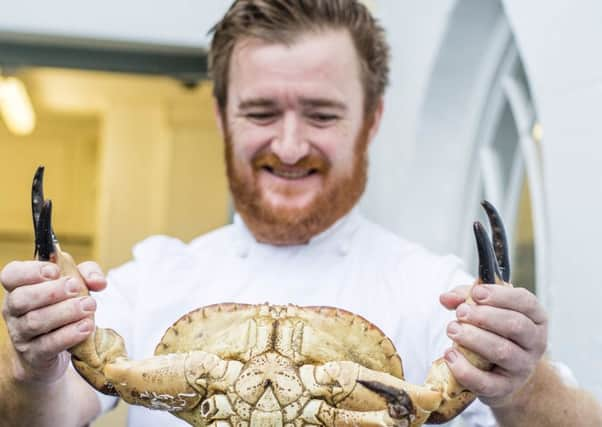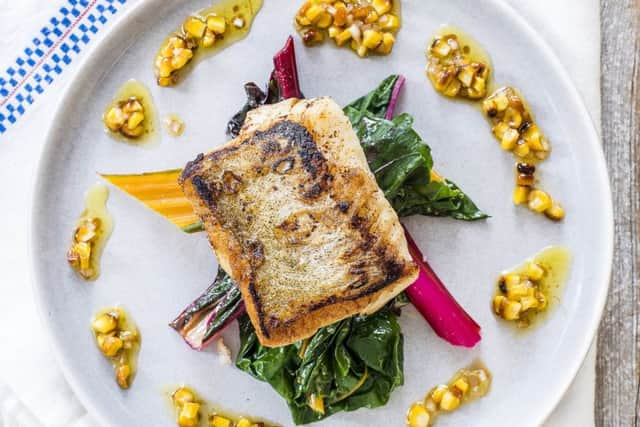Jack Stein: Our parents were virtual strangers most of the year


Jack Stein is frank about the premise of his debut cookbook - he pretty much nicked it off his TV legend and traveller-cum-chef extraordinaire dad.
‘‘I’ve basically stolen one of Rick’s ideas that he didn’t really capitalise on,’’ says Stein, wryly.
Advertisement
Hide AdAdvertisement
Hide Ad‘‘You can’t plagiarise within your own family, I’ve discovered.’’


The 36-year-old is Rick Stein’s middle son, and chef director of the Stein empire. Based in Cornwall, he’s responsible for developing and implementing menus across the family’s restaurants, and now he’s preserved a slew of his favourite recipes - some borrowed, some adapted, some all his own - in Jack Stein’s World On A Plate, his debut cookbook.
The idea he thrifted from his dad was to collect ideas, magpie-like, from his travels and then reproduce them with British produce.
‘‘We’ve travelled the world and found these amazing recipes and ingredients,’’ says Stein, ‘‘but what Dad does when he comes back to England is, he does them with local, British ingredients.’’
Advertisement
Hide AdAdvertisement
Hide AdIt’s a kind of fusion cooking Stein calls ‘‘very iconoclastic - it doesn’t really have any rules this book, it’s just whatever I think works’’. As a result, he’s clear: ‘‘If you’re a purist, this book’s not for you.’’


There’s nothing wrong with borrowing flavours - but some culinary greats can get sniffy about it
‘‘People with a great culinary history, like the French and the Italians, can have a big problem with it,’’ he says, of cherry-picking and mixing flavours from different cuisines. ‘‘What Britain and America are doing now is getting to their level in terms of provenance of food, quality of ingredients and understanding the seasons, and the Italians and the French have been doing that forever.
‘‘I guess, their point is: ‘Our cuisine has been built with these fundamentals and you’re just building a new cuisine with everyone else’s’.’’
Advertisement
Hide AdAdvertisement
Hide Ad‘‘For the British, the Americans and the Australians,’’ he continues, ‘‘we’re quite young in our appreciation of really good food, so I think it’s quite fun to say, ‘Well, I quite like a bit of everything’.’’
There’s always a new country to visit and a new cuisine to try
For three months a year, setting off in December, the whole Stein family would travel the world together. The other nine months, Stein’s parents were busy running their Cornwall restaurants. They ‘‘were virtual strangers to their three offspring’’, he writes in the book.
He slurped oysters in France for the first time aged four, witnessed the poverty of India at 11, and went on to work in kitchens in Sydney, Paris and Switzerland - but the cuisine that’s most surprised and intrigued him is that of Spain.
Advertisement
Hide AdAdvertisement
Hide Ad‘‘I know it’s not very far away, but when you’re long-haul and you land in Singapore or Bangkok, and it’s night-time and you’re having a beer and all these crazy flavours, that’s what you go for. But,’’ he continues, ‘‘I always thought Spanish food was just tapas, and a bit of paella.’’
That changed on a recent trip to San Sebastian with his dad for Rick’s Spanish series: ‘‘It was like, this place is mental!’’
They ate at cult wood fired restaurant Etxebarri (in the world’s top 10 restaurants) and Restaurante Arzak, famed for its Basque food, all the while gorging at tapas and pintxos bars.
‘‘In one day, we did more incredible eating than I’ve ever known and we didn’t even scratch the surface of San Sebastian, let alone Spain,’’ says Stein reverently.
Advertisement
Hide AdAdvertisement
Hide AdArgentina and Brazil are next on the list - although he’s just become a first-time dad, to baby son Milo, so fatherhood and his TV show, Born To Cook, are the priority right now.
‘‘I surf and the surf’s great down there,’’ he adds.
When we talk on the phone, he’s actually looking out at the surf, the waves concealing his beloved Cornish crabs.
‘‘I love crab, it’s very sustainable, there’s heaps of it down here,’’ he says. ‘‘Just above the reef where I’m sat now, you can go down with a pole and stick it in a hole and get your own.’’
With seafood that fresh at his feet, it’s a wonder he ever leaves the country at all.
Even the son of Rick Stein can be a fussy eater sometimes
Advertisement
Hide AdAdvertisement
Hide Ad‘‘We all were a bit,’’ he admits, when asked if being a fussy eater was even an option growing up in Padstow.
‘‘Mum and dad were at work and because they were away so much, we were often with our gran and aunties and uncles, and childminders, so we did push the boundaries.’’
They were ‘‘shown quite short shrift for being fussy’’, however, and if anyone kicked off at dinner, they’d be ‘thrown out’. ‘‘I’d get thrown out a lot,’’ says Stein with a laugh.
These days, there’s almost nothing he won’t try, from locusts and crickets (including a ‘‘delicious cricket marmite’’) while surfing in Mexico, to a tarantula in Laos (‘‘which was weird, I don’t like spiders at all, that was horrible’’). He’s pragmatic about eating insects though; after all, it’s ‘‘normal for most of the world’s population, they’re just a bit strange when you first see them.’’
Advertisement
Hide AdAdvertisement
Hide AdHe thinks we’re on track for a battle akin to ‘‘VHS and Betamax, or CDs and mini discs and mp3s’’ when it comes to which will most impact western diets: eating insects, or going down the lab-grown meat route.
‘‘Lab-grown meat will probably win,’’ he says. ‘‘We shouldn’t be eating as much meat as we are for the environment, but everyone likes meat, therefore, it’s the obvious way.
‘‘I know they’ve already made a burger out of lab-grown meat,’’ he continues. ‘‘I wonder if insects might be the one that almost made it.’’
Spider disgust aside, there’s little he actively hates, except for an absolute classic: ‘‘If people ask at a restaurant, ‘Have you got any allergies?’ I say, ‘I don’t like quiche’.’’
Advertisement
Hide AdAdvertisement
Hide AdJack Stein’s World On A Plate by Jack Stein, photography by Paul Winch-Furness, is published by Absolute Press, priced £26. Available now.
HOW TO MAKE JACK STEIN’S COD WITH CHARD AND CHARRED SWEETCORN
Quite the elegant fish dish.
“I developed this dish after Ross, the farmer who supplies our restaurants, said he’d planted a lot of rainbow chard,” says Jack Stein, chef and seafood aficionado, following in father Rick’s footsteps.
“The cod is sweet and flaky, the chard is earthy, and the sweetcorn dressing has lots of savoury notes to complement the sweetness of the fish. Charring the sweetcorn gives extra depth of flavour, so either use a blowtorch or just chuck it under the grill. This dish looks as pretty as a picture.”
Ingredients:
(Serves 4)
4 cod fillets with skin on (180g each)
2tsp sea salt, plus more as needed
30ml vegetable oil
A knob of butter
200g chard, cut diagonally
A drizzle of olive oil
For the corn vinaigrette:
2 ears of sweetcorn
1tbsp sunflower oil
1tsp sea salt
1 banana shallot, minced
1tsp English mustard
A sprig of thyme
50ml cider vinegar
200ml extra-virgin olive oil
A pinch of garam masala
1tsp dark soy sauce
Method:
Advertisement
Hide AdAdvertisement
Hide Ad1. Season the cod fillets with sea salt. Heat the vegetable oil in a non-stick frying pan to a medium heat and cook the fillets skin side down for two to three minutes, until the tops of the fillets begin to change to white in colour (this method allows the skin to brown slowly). Add a knob of butter to the pan, flip the fish, turn off the heat and leave the fillets to finish cooking in the residual heat. Check the temperature with a probe; it should read 50°C. Once the fillets have reached this temperature, remove them from the pan and leave to rest. Do not clean the pan; set it aside to use later.
2. Meanwhile, make the corn vinaigrette. Husk the sweetcorn and cut the kernels from the cobs. Place the kernels in a bowl, along with the sunflower oil and one teaspoon of salt, and toss to coat. Transfer to a baking tray, place under a hot grill, on the middle shelf, and grill for about 15 minutes, turning occasionally, until the kernels start to blacken. (Or use a blowtorch for this.)
3. Place the minced shallot in a bowl. Add the mustard, thyme, cider vinegar, extra-virgin olive oil, garam masala and soy sauce, and stir together. Then add the charred sweetcorn to the mixture and stir. Set the vinaigrette aside.
4. Put the pan used to cook the fish back on the heat. Deglaze the pan with two tablespoons of water, then add the corn vinaigrette to warm it up. It should take one minute.
Advertisement
Hide AdAdvertisement
Hide Ad5. Place the chard leaves in a saucepan along with water to a depth of 5cm. Cover the pan with a lid and steam the chard over a high heat for one minute. Once wilted, add salt and olive oil to taste. Remove from the heat.
6. Divide the chard among four plates, dress it with the vinaigrette and place the cod fillets on top.